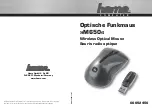
6
USB Requests – Endpoint 0
Endpoint 0 acts as the control endpoint for the host.
On power-up endpoint 0 is the default communication
channel for all USB devices. The host initiates Control- Read
and Control-Write (see Chapter 8 of the USB specification)
to determine the device type and how to configure com-
munications with the device.
In this particular design, only Control-Read transactions are
required to enumerate a mouse. For a list of valid requests,
see Chapter 9 of the USBG specification. In addition to the
standard “Chapter 9” requests, a mouse must also support
all valid HID class requests for a mouse.
USB Requests – Endpoint 1
Endpoint 1 is the data transfer communications channel
for mouse button, wheel, and movement information.
Requests to this endpoint are not recognized until the host
configures endpoint 1. Once this endpoint is enabled, then
interrupt IN requests are sent from the host to the mouse
to gather mouse data. When the mouse is left idle (i.e. no
movement, no new button presses, no wheel movement)
the firmware will NAK requests to this endpoint. Data
is only reported when there is a status change with the
mouse.
Two HID report formats are used in this design. The boot
protocol, as defined by the HID specification, is the default
report protocol that all USB enabled systems understands.
The boot protocol has a three-byte format, and so does
not report wheel information. The HID report descriptor
defines the report protocol format. This format is four
bytes and is the same as the report format with the
exception of the fourth byte, which is the wheel informa-
tion. Appendix E lists the USB Data Reporting Format.
USB Interface
All USB Human Interface Device (HID) class applications
follow the same USB start-up procedure. The procedure is
as follows:
1. Device Plug-in
When a USB device is first connected to the bus, it is
powered and running firmware, but communications
on the USB remain non-functional until the host has
issued a USB bus reset.
2. Bus Reset
The host recognizes the presence of a new USB device
and initiates a bus reset to that device.
3. Enumeration
The host initiates SETUP transactions that reveal
general and device specific information about the
mouse. When the description is received, the host
assigns a new and unique USB address to the mouse.
The mouse begins responding to communication with
the newly assigned address, while the host continues
to ask for information about the device description,
configuration description and HID report description.
Using the information returned from the mouse,
the host now knows the number of data endpoints
supported by the mouse
2
. At this point, the process of
enumeration is completed.
Note:
1. idVendor should be changed to the value as supplied by the
USB-IF
2. idProduct should be assigned for specific product.
3. MaxPower value should be changed as per specific circuit’s
current draw.
4. Post Enumeration Operation
Once communication between the host and mouse is
established, the peripheral now has the task of sending
and receiving data on the control and data endpoints.
In this case, when the host configures endpoint 1, the
mouse starts to transmit button and motion data back
to the host when there is data to send. At any time the
peripheral may be reset or reconfigured by the host.
USB Firmware Description
A function call map for USB operation is shown in
Figure 6. The following are descriptions of the functions
in
SPCP826A _A60X0.asm.
•
IO_initial
–
This function is use to set the Sunplus
microcontroller as input or output.
Port A(PA) is set as input while both Port B(PB) and
Port C(PC) are set as output. This function also includes
setting and enabling of pull-up resistors for left, right
and middle buttons.
•
clear_ram
–
This function clears the internal RAM of the
microcontroller.
•
Usb_initial
–
This function is used to enable the USB
mode. This is done by enabling the watchdog and LVR
and selecting low speed. The USB reset event interrupt
as well as the set up event interrupt are enabled.





























